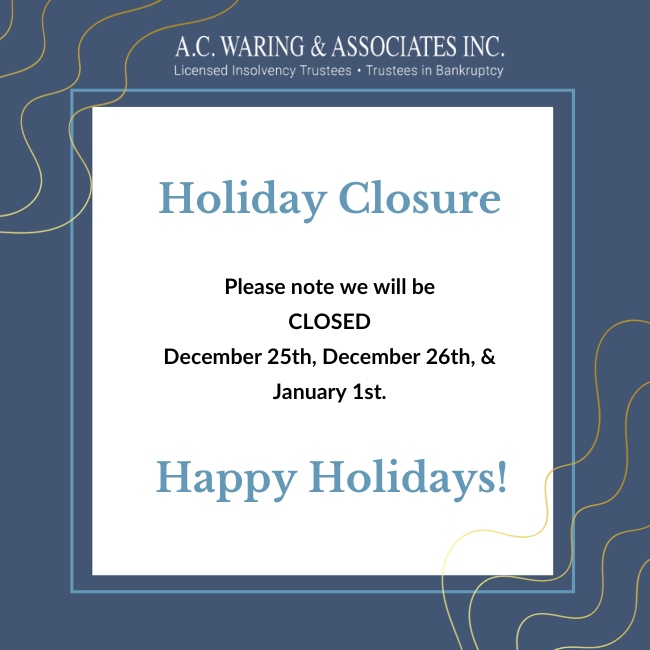Individuals facing debt issues beyond their capability to repay them need to understand what alternatives are available to them as soon as possible. Assuming getting extra income and paying down debts owed has not worked so far, talking to a federally appointed Trustee about rights and obligations to repay may be a saving grace. Bankruptcy may be one alternative depending on your financial circumstances. There may be other alternatives.
In this post, we aim to help you gain an understanding of what bankruptcy is, some basic terms associated with bankruptcy, the general process behind filing for bankruptcy, and what you can expect while you move through the bankruptcy process.
What is Bankruptcy?
Bankruptcy is a legal process that is designed to offer relief to individuals with debt. Once bankruptcy has been declared the debtor is released from their obligation to repay the debts they carried before declaring bankruptcy, though not all debts will be discharged.
In Canada, bankruptcy proceedings are governed by the Bankruptcy and Insolvency Act (BIA). The purpose of this Act is to balance the needs of debtors and creditors. This is done by providing people, unable to pay their debts, the ability to obtain relief from what they owe while also ensuring that creditors are treated equally and fairly. The Act specifically designates licensed Trustees to formally handle these matters. Trustees are appointed by the federal Office of the Superintendent of Bankruptcy.
What is a Debtor & Creditor?
A debtor refers to the individual who owes money to another party. This person is legally obligated to pay the amount they owe to the person or organization to whom that money is owed.
A creditor is a person or organization that lent the debtor money or extended credit.
For example, you go into a bank and take out a loan. The bank is now the creditor, and you are now the debtor.
The General Process Behind Filing for Bankruptcy and What to Expect
To file for bankruptcy, you must owe at least $1000. You must also be insolvent, which means you are in a situation where you are not able to pay the debts that you owe by the date they are due. The entire bankruptcy process takes around nine months, assuming that this is your first bankruptcy, your excess income over the BIA guideline is less than $200.00 and there are no creditor objections.
Step One: Choose a Licensed Insolvency Trustee (LIT)
To file for bankruptcy in Alberta, you must go through a Licensed Insolvency Trustee (LIT), who will administer your bankruptcy estate.
Funds received in your bankruptcy estate will be divided among your creditors and pay the costs of administration. If your non-exempt property or excess income is significant it will go toward discharging at least some of your debt. This means that your creditors will get paid some of the money you owe them.
Step Two: Prepare a Statement of Affairs
The Statement of Affairs, which your Licensed Insolvency Trustee will help you prepare, is a comprehensive list of all of your assets, your income, your creditors, and any other relevant information about which the Trustee will discuss. This document is sworn to be true when you sign it.
Step Three: File for Bankruptcy
Once you have your Statement of Affairs in order, your Licensed Insolvency Trustee will help you file for bankruptcy. If your creditor listing is significantly large or a creditor files a complaint, you may, although rarely, have to attend a bankruptcy interview with the Official Receiver, a government official who works at the Office of the Superintendent of Bankruptcy. The Official Receiver will review your documents and act as the chair for a meeting of your creditors to discuss your conduct and the specific causes of your bankruptcy.
Most individuals filing for bankruptcy will never come in contact with an Official Receiver. Instead, their Trustee will fulfill some of the roles of the Official Receiver such as chairing these meetings.
Step Four: Attend Two Financial Counselling Sessions
You may attend these sessions either with your Licensed Insolvency Trustee or a designate. Whoever conducts these sessions must be authorized to do so pursuant to the Bankruptcy and Insolvency Act (BIA) and have obtained the RQIC (Registered and Qualified Insolvency Counsellor) designation. The first session typically takes place during the second month of your bankruptcy process, and the second takes place around six months through the process.
The purpose of these financial counseling sessions is to help you learn to manage your budget, financial affairs, and future credit differently in order to avoid falling into financial difficulty again.
Throughout the Bankruptcy Process
Under the BIA the bankrupt must assist the Trustee in dealing with assets that are available under law. During the bankruptcy, you will have to report all income and expenses, monthly, as well as pay a monthly amount, set by your Trustee, into a Bankruptcy Estate account. This set monthly payment is based on the amount of your earnings and your number of family dependents.
Once you are discharged from bankruptcy, you have no further obligations to pay the remainder of your debts that were covered in your bankruptcy subject to a few specific protected debts listed in Bankruptcy and Insolvency Act.
Who and What is a Licensed Insolvency Trustee (LIT)?
Licensed Insolvency Trustees (LIT) are federally regulated appointees whose job it is to provide advice and service to individuals and businesses struggling with debt problems, as well as helping people make informed decisions about how to deal with their financial difficulties. They are guided by the provisions of the BIA as well as the Directives set forth by the federal Office of the Superintendent of Bankruptcy.
Licensed Insolvency Trustees are the only appointees authorized to administer the government regulated insolvency proceedings that will allow you to get relief from your financial obligations. You do not need a referral to talk to a Trustee. You can call a Trustee directly.
How Do They Help You?
Licensed Insolvency Trustees will discuss and consider the size of your debt load, your assets, your specific creditors and discuss your debt options. Should bankruptcy proceedings be that option, the Trustee will compile your information into a Statement of Affairs which will be needed to file for bankruptcy. Your Trustee will also help you understand the bankruptcy process and provide you with your two mandated financial counseling sessions. You must undergo these sessions in order to obtain your eventual discharge from bankruptcy. These sessions are designed to help you avoid falling into financial difficulties in the future by helping you learn how to manage your finances and future credit better.
Your Trustee will intervene between you and your creditors. In summary, your Licensed Insolvency Trustee is there to help you navigate the bankruptcy process, get your financial affairs in order, help you learn how to avoid bankruptcy in the future, and speak to your creditors and the government on your behalf.
What Property is Exempt?
Some basic assets are protected by provincial law to ensure that your bankruptcy does not cause you to fall further into dire financial straits.
The assets protected in Alberta include:
- Twelve months worth of food
- Clothing items up to $4,000
- Household furniture and appliances up to $4,000
- One motor vehicle worth up to $5,000
- Equity in your primary residence up to $40,000. This is reduced to your share if you are a co-owner.
- Tools of your trade worth up to $10,000
- If your main source of income is farming, you may keep up to 160 acres of farmland
- Social allowance, handicap benefits, or a widow’s pension if the benefits are not co-mingled with your other funds.
- Any health assistive devices
Though bankruptcy follows a fairly standard process, everyone’s financial situation is different. Your Trustee will help you understand the process, advise you based on your unique financial situation and needs, and help you learn to better manage your finances moving forward.
How Should I Proceed?
If you are considering ways to deal with overwhelming debt issues, you should speak with a Licensed Insolvency Trustee. Trustees can help you assess your financial situation, offer advice, and help you determine if bankruptcy, or an alternative, is the right course of action for you.
Often we can advise you over the phone. Depending on your circumstances, each situation is different and an in-person consultation is always free.
You don’t need to weather your financial troubles alone. You can call a Trustee directly. A referral is not necessary. A.C. Waring & Associates Inc. is here to help.
Call us at 780-424-9944 or just Drop In to our office inside First Edmonton Place at 10665 Jasper Ave, Suite 410. Our office is on the 4th floor above Tim Horton’s on Jasper Ave. Parking is easily available in the area and the Corona LRT is your stop for First Edmonton Place.

Stan Romaniuk
Licensed Insolvency Trustee
A. C. Waring & Associates Inc.
The Debt Solutions People®
Call Us. Talk to us. We can help.
780-424-9944
or
1-800-463-3328




